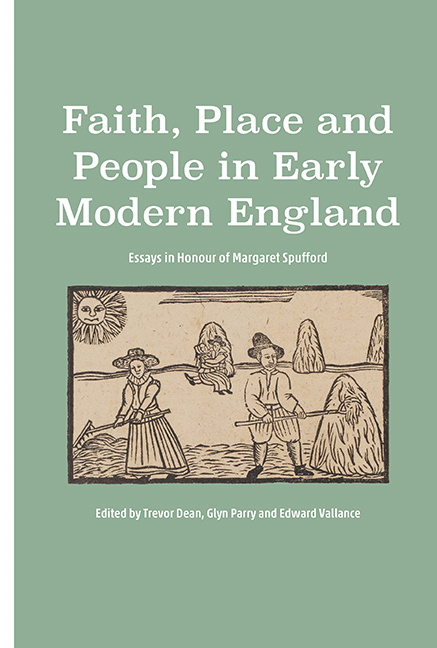Book contents
- Frontmatter
- Dedication
- Contents
- List of Illustrations
- List of Contributors
- Record Office Abbreviations
- Acknowledgements
- Introduction
- Margaret
- Part I Faith
- Part II Place
- Part III People
- 7 ‘Flowered silk is little worn but gold and silver striped is much worn’: Metropolitan Clothing Consumption in Late Seventeenth- Century Sussex
- 8 A Cuckold in Space: The ‘Ballading’ of Stephen Seagar, 1669
- 9 Marginal People in a Stressful Culture: Gypsies and ‘Counterfeit Egyptians’ in Margaret Spufford's England
- Bibliography of Margaret Spufford's works
- Index
- Tabula in Memoriam
7 - ‘Flowered silk is little worn but gold and silver striped is much worn’: Metropolitan Clothing Consumption in Late Seventeenth- Century Sussex
from Part III - People
Published online by Cambridge University Press: 19 July 2019
- Frontmatter
- Dedication
- Contents
- List of Illustrations
- List of Contributors
- Record Office Abbreviations
- Acknowledgements
- Introduction
- Margaret
- Part I Faith
- Part II Place
- Part III People
- 7 ‘Flowered silk is little worn but gold and silver striped is much worn’: Metropolitan Clothing Consumption in Late Seventeenth- Century Sussex
- 8 A Cuckold in Space: The ‘Ballading’ of Stephen Seagar, 1669
- 9 Marginal People in a Stressful Culture: Gypsies and ‘Counterfeit Egyptians’ in Margaret Spufford's England
- Bibliography of Margaret Spufford's works
- Index
- Tabula in Memoriam
Summary
In The Great Reclothing of Rural England, published in 1984, Margaret Spufford observed that ‘the social historian does not normally look at histories of costume with a serious analytical eye’ and that such studies of clothing as there were typically focused on the clothing of the elite. Spufford's analysis of the stock-in-trade of itinerant traders was, as she described, her initial attempt to explore the clothing of the non-gentle. As she acknowledged, the main difficulty with exploring non-elite clothing culture in the seventeenth century is the lack of coherent documentary evidence. Spufford subsequently identified what she described as a ‘new’ source (in the sense that it was a source that had been under-exploited) for this purpose, the probate account. Using evidence from some 800 accounts she published two articles about the cost of clothing in the seventeenth century.
Spufford was right to draw attention to the paucity of sources for the clothing of the non-elite, although coverage of non-elite groups is uneven. Below the elite those for whom the most coherent documentary sources survive are the poor, since parish overseers’ accounts frequently record the cost of clothing the parish poor. The poor were also typically the perpetrators and victims of clothing and textile theft, and a surprising amount of information about their clothing and its provenance can be found in Quarter Sessions records. Perhaps the most intractable in terms of documentary sources are the ‘middling sort’ – yeomen, more affluent husbandmen and trade and craftsmen. Probate inventories are informative about the domestic material culture of this group, but they generally record little or nothing about clothing; wills, as Spufford pointed out, are ‘slow to mine’ and provide no information about provenance. One source for this group, as Spufford identified, are probate accounts, but of course these only record the clothing of minor children and, like wills, they seldom supply information about clothing provenance. It is perhaps because of these evidential difficulties that the study of seventeenth-century non-elite clothing is still a relatively neglected area, in contrast to the eighteenth century, which is now reasonably well covered. At the present time the two most substantial monographs on seventeenth-century clothing remain Aileen Ribeiro's Fashion and Fiction: Dress in Art and Literature in Stuart England and Susan Vincent's Dressing the Elite: Clothes in Early Modern England, both of which deal exclusively with the elite.
- Type
- Chapter
- Information
- Faith, Place and People in Early Modern EnglandEssays in Honour of Margaret Spufford, pp. 153 - 174Publisher: Boydell & BrewerPrint publication year: 2018



